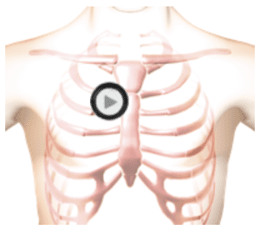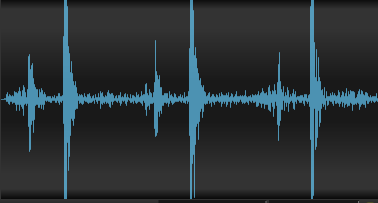First Heart Sound plus Aortic Ejection Click
A single first heart sound (S1) followed by an aortic ejection click (AEC) can also mimic a split first heart sound. An AEC follows S1 by 50 milliseconds. An aortic ejection click is caused by thickened aortic valve leaflets. This is commonly seen in a bicuspid aortic valve, a congenital abnormality where someone is born with two aortic valve leaflets instead of the normal three. Listen carefully to the second sound of the pair. If it is an AEC it will have a shorter duration and a higher pitch than the first sound of the pair (S1). The AEC is best heard at the Aortic valve area where splitting of S1 is not heard.Auscultation Sounds


Patient Recording of First Heart Sound plus Aortic Ejection Click


Patient Recording - Half Speed


Position

The patient's position should be sitting.
Listening Tips for First Heart Sound plus Aortic Ejection Click
Systole:high-pitched sound, early in systole, short durationWaveform (Phonocardiogram)
Observe Cardiac Animation for First Heart Sound plus Aortic Ejection Click
An aortic ejection click is caused by thickened aortic valve leaflets. This is commonly seen in a bicuspid aortic valve, a congenital abnormality where someone is born with two aortic valve leaflets instead of the normal three.
Authors and Sources
Authors and Reviewers
- EKG heart rhythm modules: Thomas O'Brien.
- EKG monitor simulation developer: Steve Collmann
-
12 Lead Course: Dr. Michael Mazzini, MD.
- Spanish language EKG: Breena R. Taira, MD, MPH
- Medical review: Dr. Jonathan Keroes, MD
-
Heart sounds and mentorship: W. Proctor Harvey, MD
- Medical review: Dr. Pedro Azevedo, MD, Cardiology
-
Last Update: 1/8/2023
Sources
-
Electrocardiography for Healthcare Professionals, 5th Edition
Kathryn Booth and Thomas O'Brien
ISBN10: 1260064778, ISBN13: 9781260064773
McGraw Hill, 2019 -
Rapid Interpretation of EKG's, Sixth Edition
Dale Dublin
Cover Publishing Company -
12 Lead EKG for Nurses: Simple Steps to Interpret Rhythms, Arrhythmias, Blocks, Hypertrophy, Infarcts, & Cardiac Drugs
Aaron Reed
Create Space Independent Publishing -
Heart Sounds and Murmurs: A Practical Guide with Audio CD-ROM 3rd Edition
Elsevier-Health Sciences Division
Barbara A. Erickson, PhD, RN, CCRN - Clinical Heart Disease
W Proctor Harvey, MD
Clinical Heart Disease
Laennec Publishing; 1st edition (January 1, 2009) -
The Virtual Cardiac Patient: A Multimedia Guide to Heart Sounds, Murmurs, EKG
Jonathan Keroes, David Lieberman
Publisher: Lippincott Williams & Wilkin)
ISBN-10: 0781784425; ISBN-13: 978-0781784429 - Project Semilla, UCLA Emergency Medicine, EKG Training Breena R. Taira, MD, MPH
First Heart Sound plus Aortic Ejection Click | #43